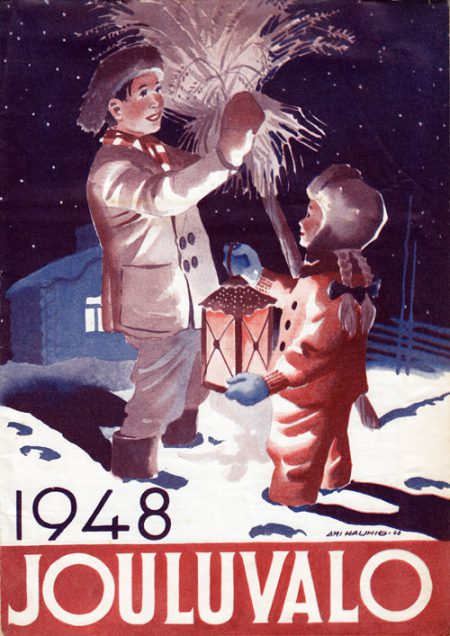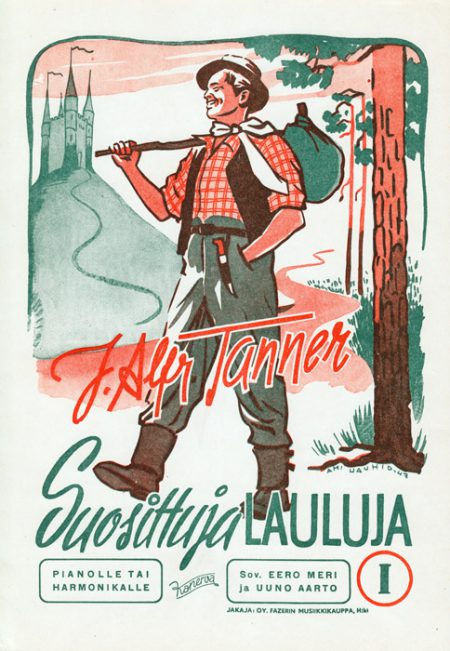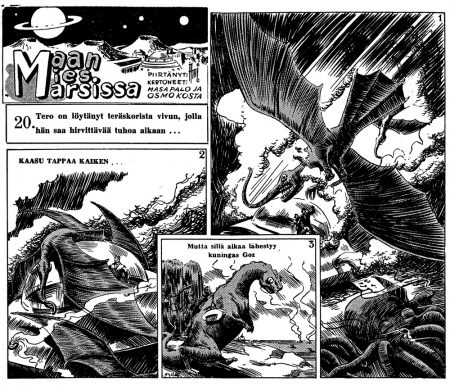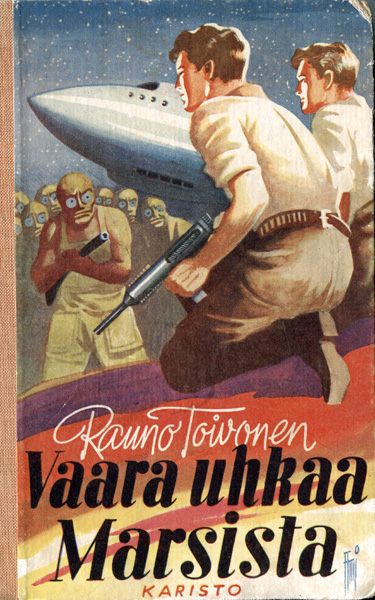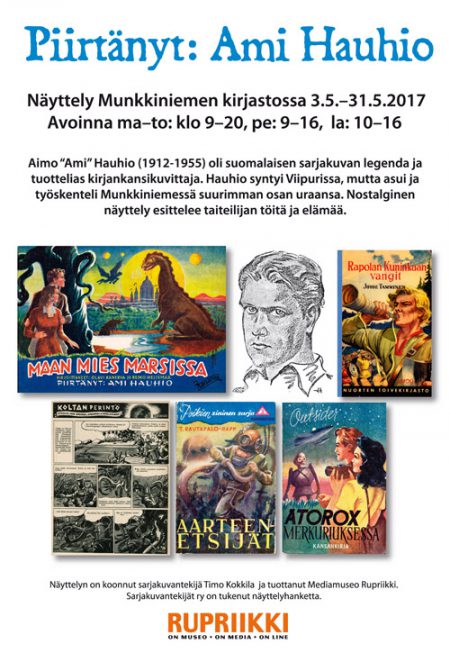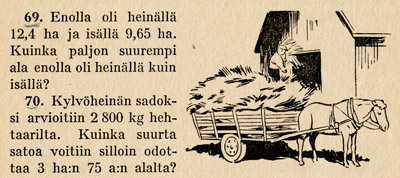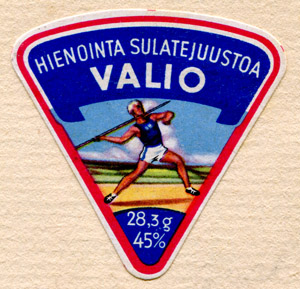The touring exhibition of Finnish comics artist and illustrator Ami Hauhio’s art is displayed at Worldcon 75 in Helsinki, Finland 9–13 August 2017. The exhibition is in Finnish, but here you can find a summary of the texts in English, including some art samples.
The exhibition was produced by Media Museum Rupriikki. Curator of the exhibition: Timo Kokkila. Graphic Design: Lasse Honkanen. Contact: tkokkila@yahoo.com

Aimo ”Ami” Hauhio 1912–1955
Aimo Hauhio was a Finnish comics artist and illustrator, who signed his work with pseudonym Ami. He was born in Vyborg in 1912, his parents were Robert and Lyyli Hauhio and he had two younger brothers.
Aimo’s father drowned tragically during a boat trip in Vyborg Bay in 1923. Aimo studied in Vyborg Art Society Drawing School in 1926–1932. After graduating he worked in a printing house. His illustrations and comics also started to appear here and there.
In 1938 Aimo married Kerttu Suomalainen and they had a son in 1939. The family moved from Vyborg to Munkkiniemi in Helsinki, just before the Second World War started. During the war Vyborg was evacuated and the town was more or less destroyed. Vyborg became part of the Soviet Union in 1944.

At wartime Aimo worked drawing maps in the Finnish National Board of Navigation. His wife and son moved to safer Sweden, where Kerttu gave birth to a daughter. In Helsinki Aimo was busy drawing adventure comics and book covers after work.
After the war Kerttu and children returned to Helsinki. Aimo worked as a layout artist for magazines and as an illustrator in advertising agencies. At home he often worked until late night with his own work. He made comics, illustrations and book covers, but also paintings and wood carvings. His hobbies included fishing and hunting, but also films and art organization work. Two more children were born to the family.
Aimo got stomach cancer in early 1950’s. After a successful surgery he kept on working as a freelance artist. In 1955 he got sick again and died in December, only 43 years old. Short but productive career ended much too early.
Adventures in comics
Weekly family magazine Seura organised a comics contest in 1936. Hauhio won the second prize with ”Border Control Sergeant Kuula” (Rajavartiokersantti Kuula). The winner was famous Finnish illustrator Martta Wendelin, whose historical comic ”The Mystery of the Golden Chalice” (Kultaisen pikarin salaisuus) was soon published. Hauhio’s Sergeant Kuula was never seen, but his full color series ”Pilot Sam Hurja’s adventures on land, sea and air” appeared on Seura’s pages in 1938–1939.
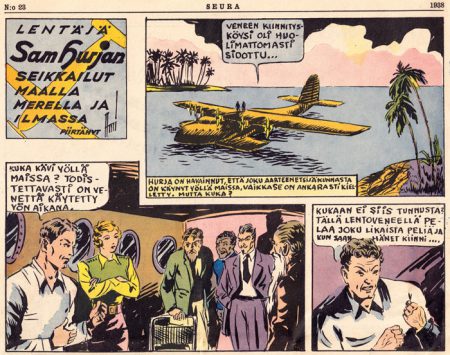
On wartime and after that early Finnish syndicate Tekijätoimisto (Maker-office) distributed Finnish comics. Hauhio’s strips like ”Ismo Lento, Son of the Borderland” and ”Border Patrol Topi Valpas” were published in several newspapers.
Popular Finnish radio adventure serial ”Pekka Lipponen and Kalle-Kustaa Korkki” was adapted for a comic strip by Hauhio in 1950. The writer Outsider (Aarne Haapakoski) was well known and productive writer. The problem with the strip was that weekly half-page comic followed the same story as the daily radio show. The impossible pace lost most of the charm of the original.
Hauhio mentioned in a rare interview, that he considered comics as a media of the future. But after the Second World War American comics really started to take over Finnish papers and local artists were mostly put aside.
Science Fiction Visions

Earthman on Mars -album from 1947.
The most famous of Ami Hauhio’s comics was ”Earthman on Mars” (Maan mies Marsissa) in Finnish pulp magazine Isku in 1940–1941. The story was written by popular writer and song lyricist Reino Helismaa and Olavi Kanerva. Hauhio’s art is more painstakingly done than usually. It was published also as an incomplete comic book in 1947 and as a restored version in 2011. Earthman on Mars was influenced by Flash Gordon, and Hauhio later regretted that in an interview. He was being too hard for himself, the artwork is still impressive.
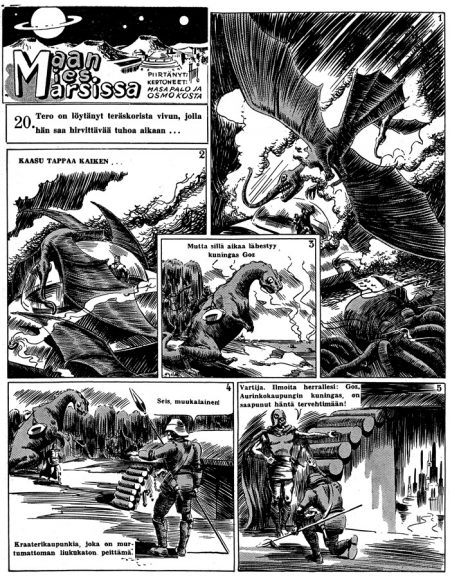
Magazine Valojuova published Hauhio’s fantasy oriented Lapland adventure ”Skolt’s Legacy” (Koltan perintö) in 1944–1946. The sequel in Pellervo-magazine 1947–1950 was pure science fiction with a story about a landtorpedo that can travel through Earth and under water.
Pulp magazine World of Adventure (Seikkailujen maailma) published Hauhio’s scifi comic ”Patent number 33” in 1940–1942. The Flying Saucer (Lentävä lautanen) appeared with 3-color printing in 1953, and was written by Olavi Kanerva.

Hauhio’s probably best known scifi book covers are Aarne ”Outsider” Haapakoski’s Atorox novels. The main character, robot Atorox has also given its name to annual Finnish award for the best science fiction short story, given out by Turku Science Fiction Society. Some Finnish translations of Edgar Rice Burrough’s books had covers by Hauhio. Many books aimed for teens also had scifi or fantasy elements.

Atorox on Mercury, 1948 / Treasure Hunters, 1945 / Danger from Mars, 1949 / Lost on Venus (Finnish translation of the name is ”The Princess of Venus”), 1951
Adventures for the Young People
Maybe the most remembered works by Ami Hauhio were Finnish book covers aimed for teens in 1940’s and 1950’s. Adventure books for boys were popular at the time and there were a lot of them from many publishers. Some of the books are better remembered because of their covers than the actual stories, which were often poorly written and formulaic. Still, many classics of the genre are also included.

The Battle of Rome (Ein Kampf um Rom), 1951 / The Prisoners of the King of Rapola, 1955
Very popular series Nuorten toivekirjasto (Wish-library for Youths) by big Finnish publisher WSOY had about 20 covers by Hauhio in 1953–1955.

The Odyssey of the Black Schooner, 1947 / The Adventure under the the Sea, 1948
The Blue Series for Boys (Poikien sininen sarja) by publisher Kansankirja had Hauhio covers in all 21 books, except one. Also children’s magazine Kimmo had many covers by him in 1945–1950.
Comics for the Whole Family
Ami Hauhio made also humour and lighter stories. In 1939 magazine Seura published his full page comics about Family Seuranheimo. The father of the family is a wanna-be poet who works in a liver sausage company. After the war Hauhio returned to humour with strip ”Busy Maija” (Touhukas Maija) in childrens’ magazine Kimmo.
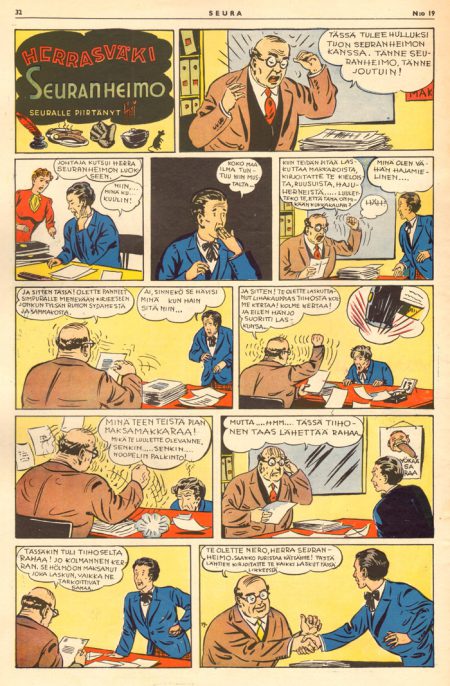
Family magazines like Koti (Home) and Yhteisvoimin (Together) printed many strips for children. Magazine Lasten maailma (World of Children) published several comics adaptations of classic novels like The Last of the Mohicans, Mowgli and Treasure Island, but also some Hauhio’s own stories like ”Adventures in Coral Island” or ”The Secret of Huhmarsaari”.
Various one shot comics appeared here and there. For example magazine Countryside Christmas (Maaseudun Joulu) 1948 had Hauhio’s two page comic chronicling Finland’s success in Olympic Games.
Thrillers and Detectives
Hauhio seems to have enjoyed making covers for adventure and thriller stories. They were usually made fast and probably the artist was not paid very much. Hauhio’s art is a personal combination of fast paced American style and more rugged Finnish tradition.
In many cases the cheap paper and poor quality of the printing adds the pulp feeling of the books. Small publishers often didn’t care too much of the details, either. In Kamppailu keksinnöstä (The Struggle for the Invention) cover, both the first and last name of the author are misspelled. Sidney Horley is actually British thriller novelist Sydney Horler.

Murder by Prescription, 1949 / The Struggle for the Invention, 1942
Hauhio knew well Finland’s best known pulp writers of the time, Aarne ”Outsider” Haapakoski and Reino Helismaa. Specially Outsider was hugely productive and Hauhio made covers for about 30 of his books. Many of the stories were first published in various Finnish pulp magazines with Haapakoski’s other exotic pseudonyms like Victor Mario, Henrik Horna or Rigor Morton.
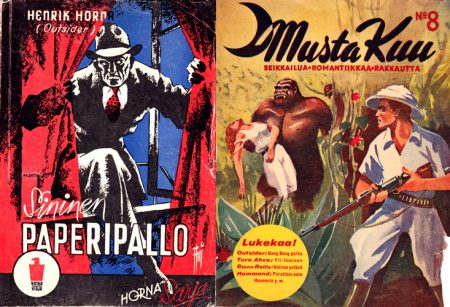
The Blue Paper Ball, 1943 / Pulp-magazine The Black Moon, 1945
Advertising and Illustration
Hauhio worked in Vyborg printing house in 1930’s and after the war in advertising agencies like Erva-Latvala and Mainosyhtymä in Helsinki. Advertisements are not usually signed and the style is generic, so the artists are hard to identify. Luckily some of Hauhio’s works have survived in a portfolio album, owned by his son.

Hauhio took part is some logo contests and made art for collectible stamps and cards for banks. Hauhio’s best known logo designs were radio-logo for Finnish Broadcasting Corporation Yle and the S-logo for the bank Säästöpankki.

Ami-Cola label is a funny example of his work, maybe the assignment was given to Hauhio just based on artist’s name. A few postcard designs came out, mostly during the wartime, and various illustration work appeared constantly in books and magazines.

Various Covers for Various Books
After the war Ami Hauhio painted book covers for many publishers. The books varied from pulp to romance and some classic foreign volumes. Many publishers have disappeared a long time ago, and so has the original art. Only a few Hauhio’s cover paintings have survived. From hundreds of pages of comics, only one original page exists.

The Day Looks Back, 1947 / Bel-Ami, 1955
The cover artists were rarely mentioned in the books of 1940’s and 1950’s. Hauhio usually marked his work with stylised signature Ami, but not always. His covers reach over 300 in a little more than 10 years time.
In his last years Hauhio’s style started to change. He found new realism for the human figures, that often used to be a little stiff before. Maybe the times and styles were changing, the artist was more experienced, or did he simply have more time?

The Days of the Decision, 1954 / Am I Good Enough for You? 1950


